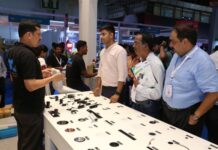TOKYO, Sept 23, 2020 – (JCN Newswire) – Fujitsu Limited today announced that it has received an order for a new supercomputer system from Canon Inc.
Highlights:
- Fujitsu’s Supercomputer PRIMEHPC FX1000 will contribute to Canon’s no-prototype development initiative in manufacturing, leveraging the technology of the world’s fastest supercomputer, Fugaku co-developed by RIKEN and Fujitsu.
- Fujitsu’s new system consists of a PRIMEHPC FX1000 with 192 nodes, with an expected theoretical computational performance of 648.8 TFLOPS.
- The new supercomputer delivers enhanced capabilities and expands the scope of applicability of analysis in Canon’s product development process.

The system consists of a Fujitsu Supercomputer PRIMEHPC FX1000(1) unit, which harnesses top-class technology from the world’s fastest supercomputer, Fugaku, which was jointly developed by RIKEN and Fujitsu. The new supercomputer will achieve an expected theoretical computational performance of 648.8 teraflops (TFLOPS)(2). Upon completion, the supercomputer will play a key role in contributing to Canon’s initiative of “no-prototype” product development(3), delivering enhanced capabilities and scope of applicability of analysis in Canon’s product development process. This system is planned to begin operations in the first half of 2021.
Background

Canon is promoting a “no-prototype” initiative in the development of its products, such as office multifunction devices and other various types of printers, cameras, and semiconductor lithography equipment. To make this initiative a reality, Canon is leveraging 3D CAD data in analytical simulations to evaluate multiple facets of proposed products, including functionality, as well as ease of manufacturing. In the past, Canon has relied on both a Fujitsu Supercomputer PRIMEHPC FX10 system and a Fujitsu Supercomputer PRIMEHPC FX100 system. Now, to take its initiative to the next level, Canon has adopted Fujitsu’s PRIMEHPC FX1000 system, which delivers reliable, high performance computing power, with world-leading energy efficiency.

Overview of the New System
Fujitsu’s new system consists of a PRIMEHPC FX1000 with 192 nodes, with an expected theoretical computational performance of 648.8 TFLOPS. Fujitsu will also deploy Fujitsu Server PRIMERGY systems and Fujitsu Storage ETERNUS systems as peripheral devices. As an important part of Canon’s product development cycle, this system will enable larger-scale analyses and simulations in impact analysis experiments evaluating damage to or deformation of a potential product when dropped, including simulations with over 100 million elements(4), a challenge for previous systems to handle. The new system will also support airflow analysis and electromagnetic wave analysis. These benefits will ultimately help to deliver an enhanced product development flow through Canon’s “no-prototype” initiative. Fujitsu’s technical computing solutions, particularly the PRIMEHPC FX1000, demonstrate an ongoing commitment to streamlining the performance, quality, and functionality of products while reducing product development times and costs for its customers.
- Fujitsu Supercomputer PRIMEHPC FX1000 Uses the A64FX CPU, which incorporates both the Arm v8-A instruction set architecture and the supercomputer-focused Scalable Vector Extension (SVE). It offers not only high performance for its power consumption, but also high computational efficiency due to its wide bandwidth HBM2 memory, a type of high performance layered memory.
- Teraflops An acronym for tera floating point operations per second. Tera refers to one trillion (1012), so one teraflop indicates a system can perform one trillion floating point operations per second.
- No-prototype initiative A company-wide initiative promoted by Canon to only build necessary prototypes, eliminating useless product prototyping through the use of testing virtualization technology based on simulation technology.
- Elements In the field of analysis technology, in order to simulate phenomena using computers, items must be broken down into component elements composed of simple shapes. More precise simulations are possible by using larger numbers of small elements.
For more information, please visit at: www.fujitsu.com.














